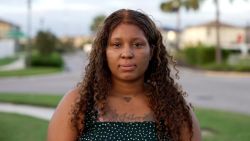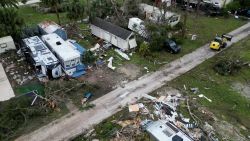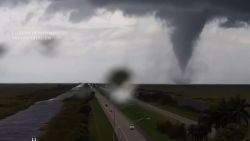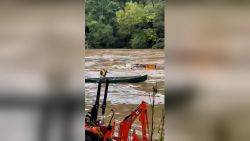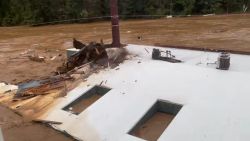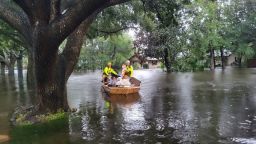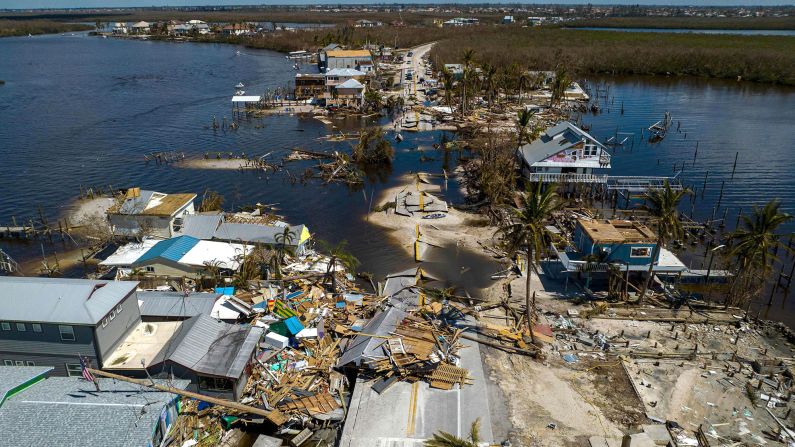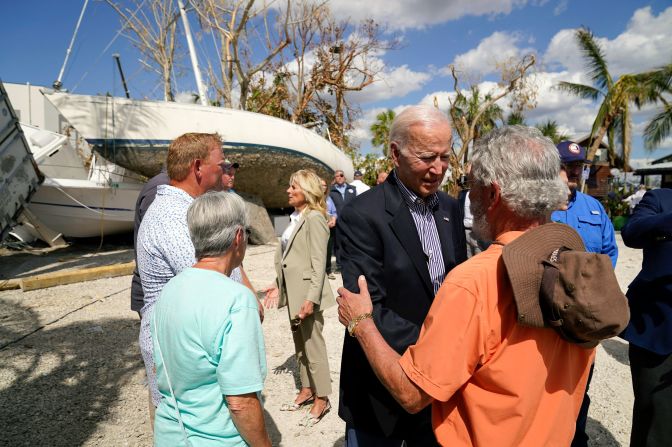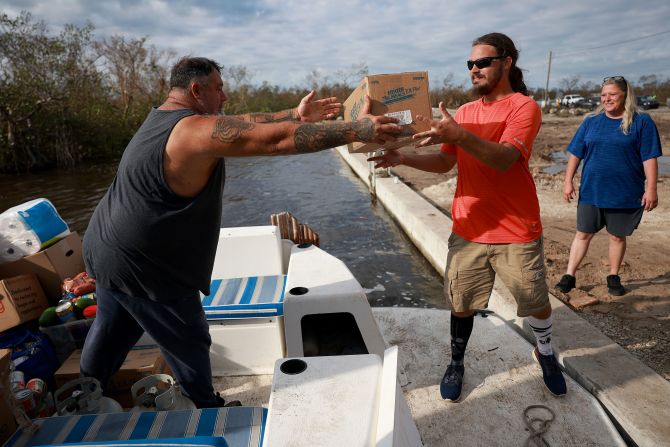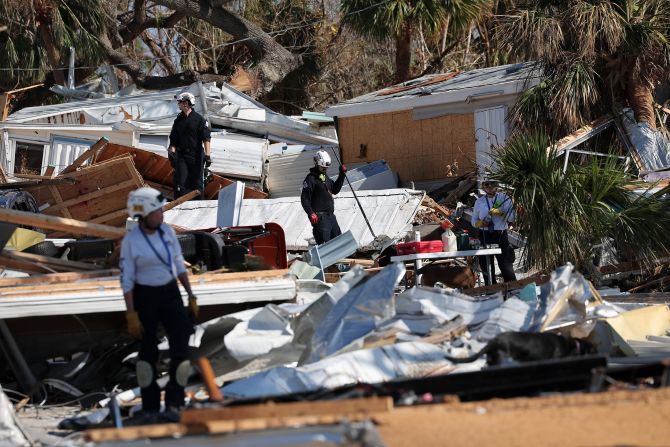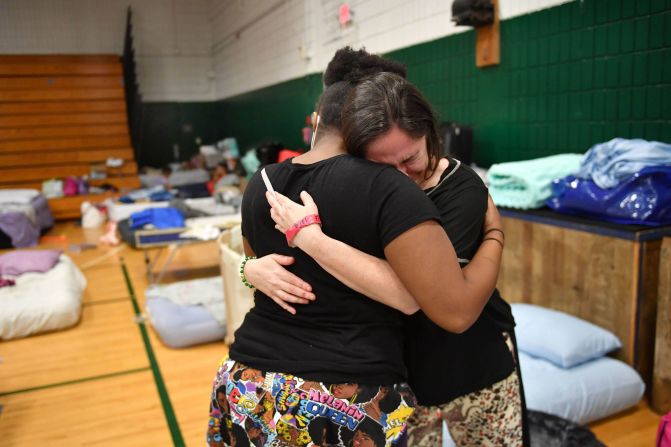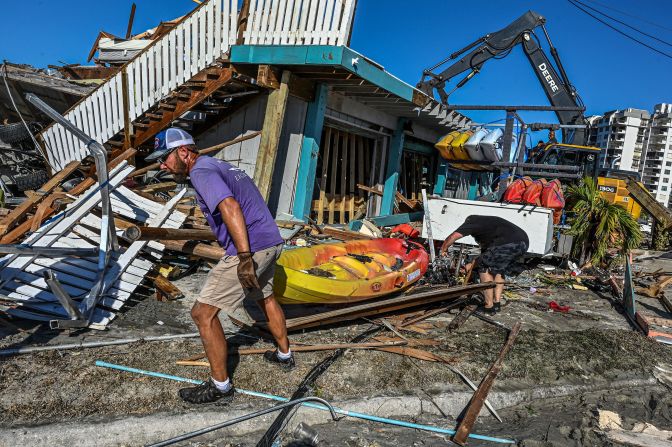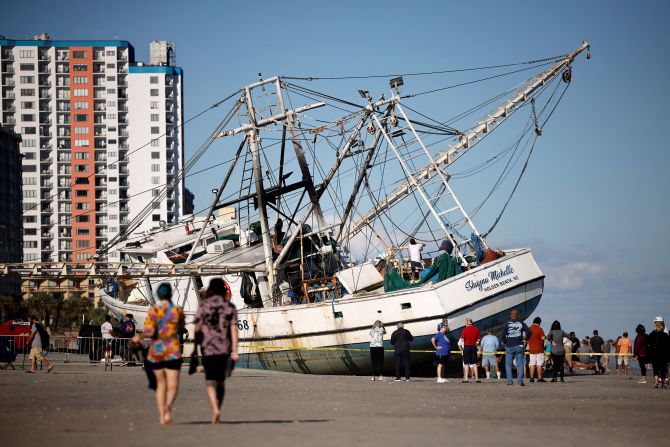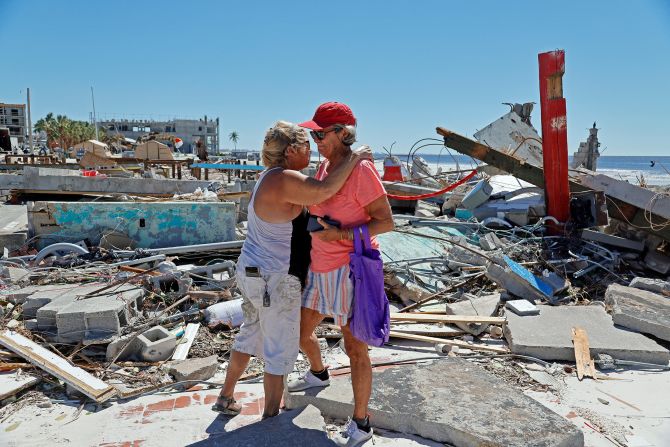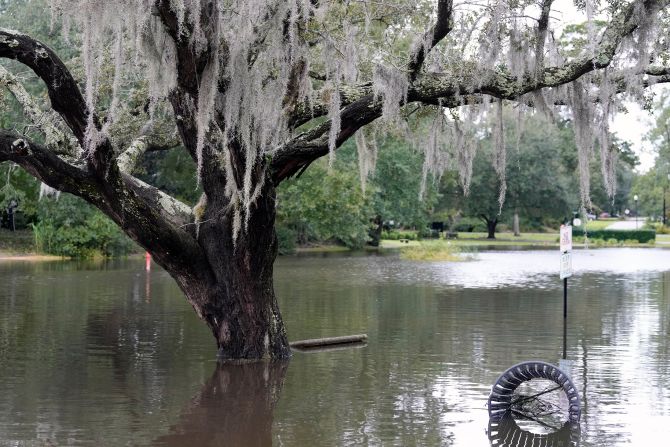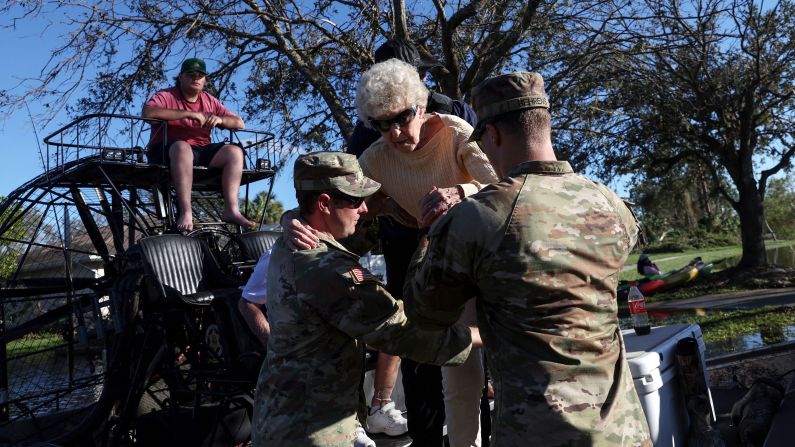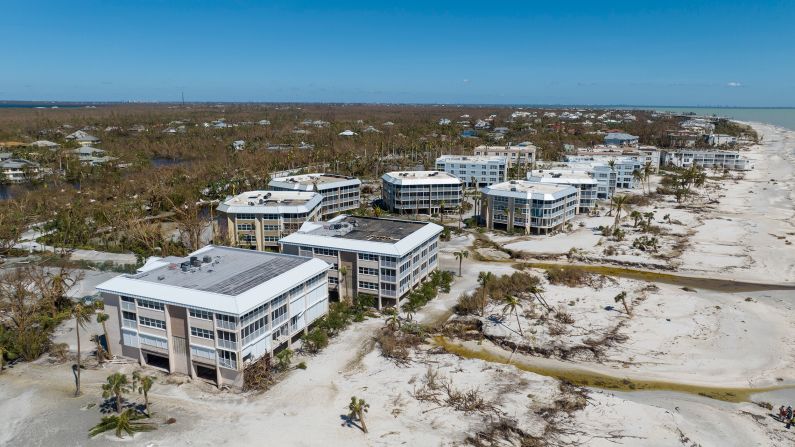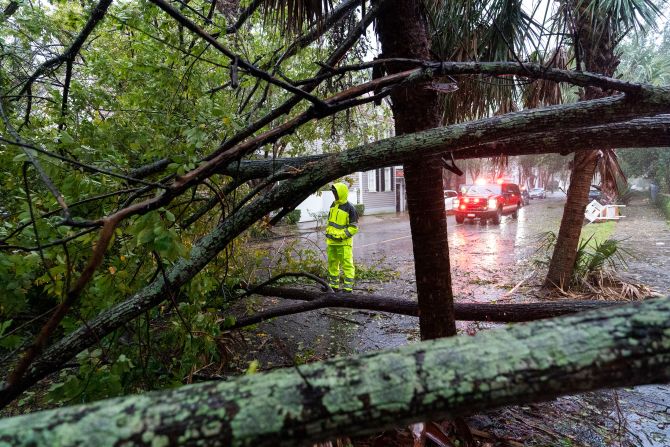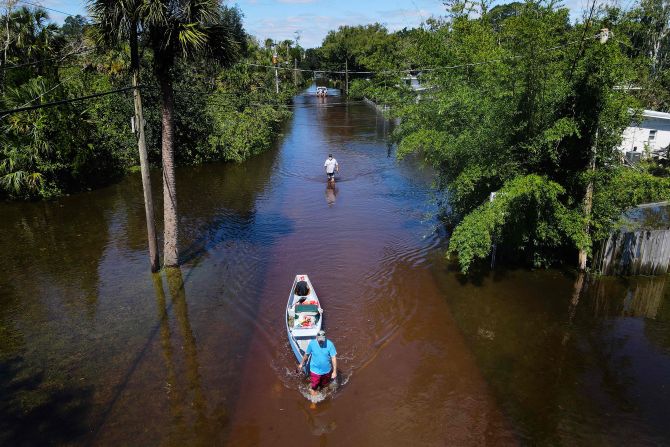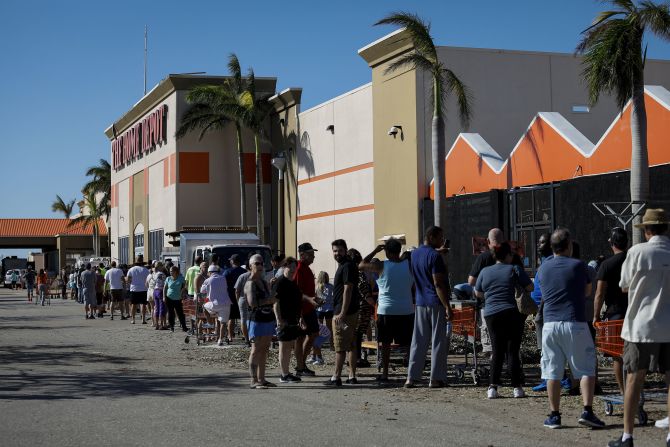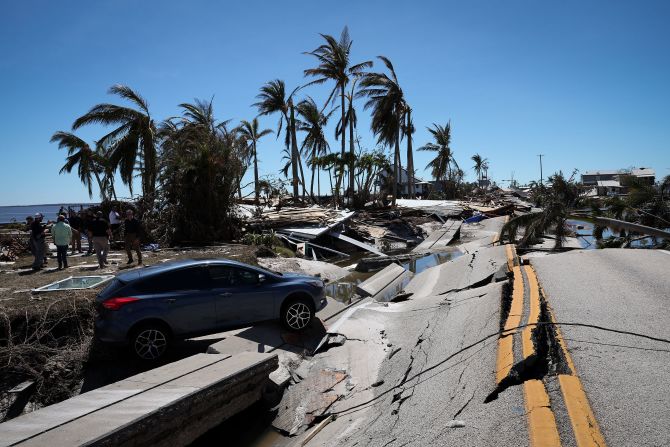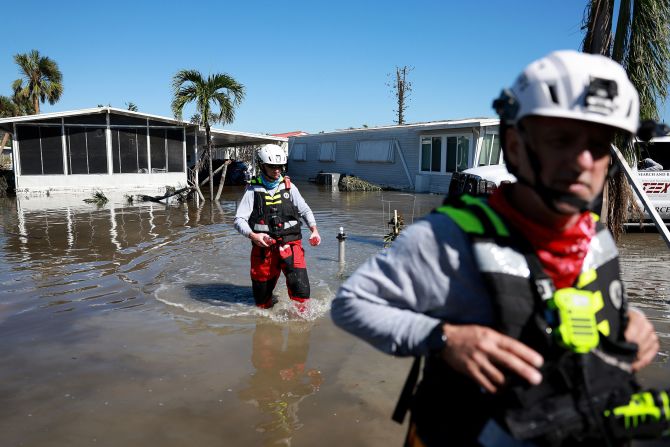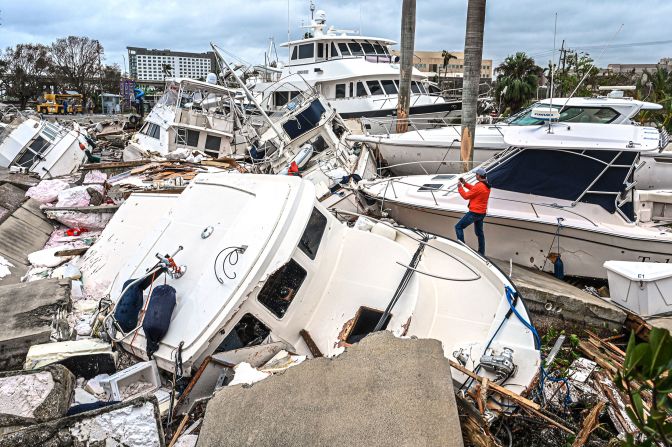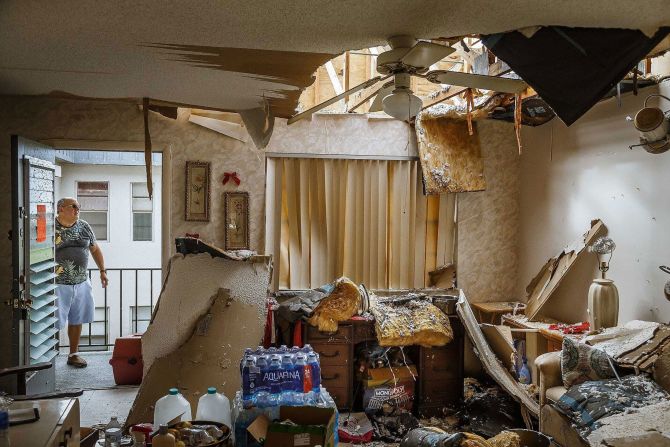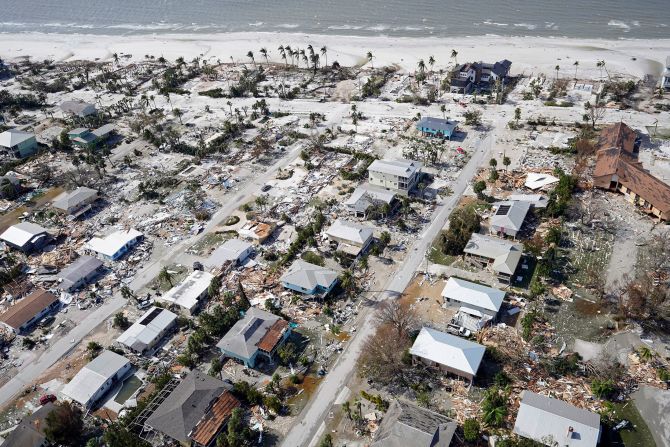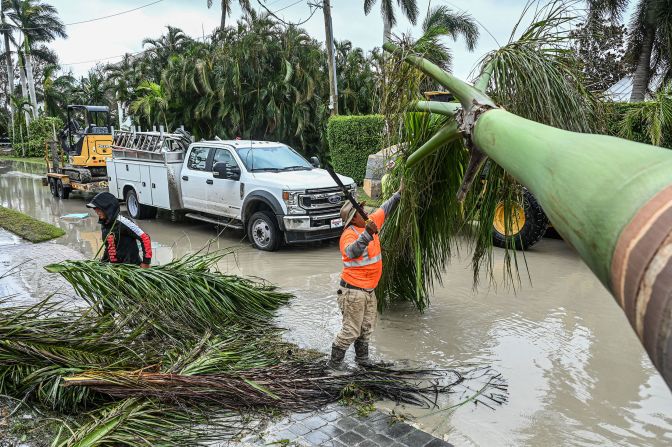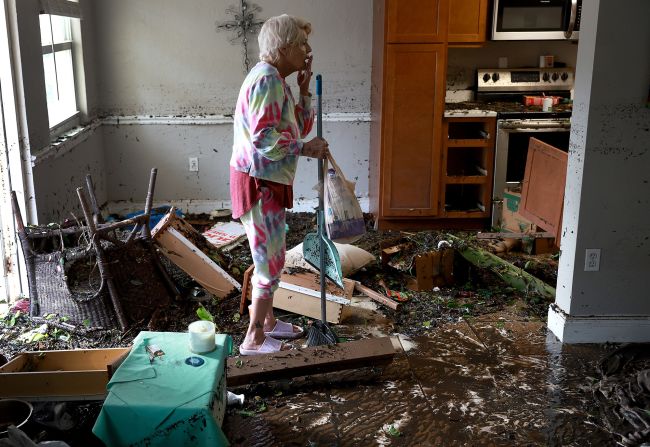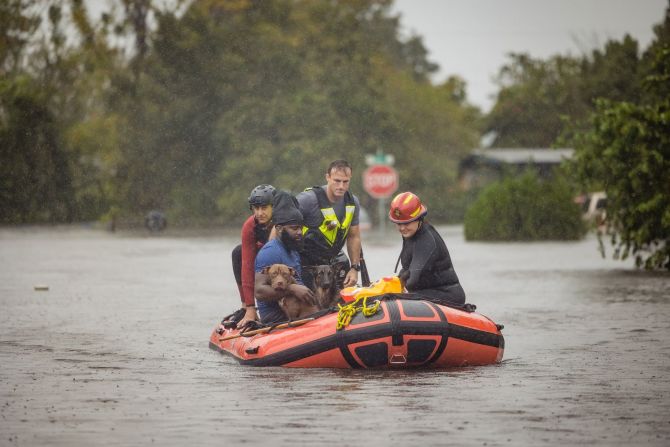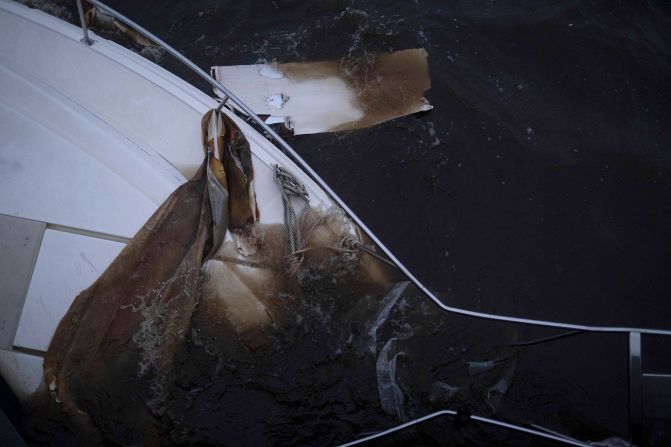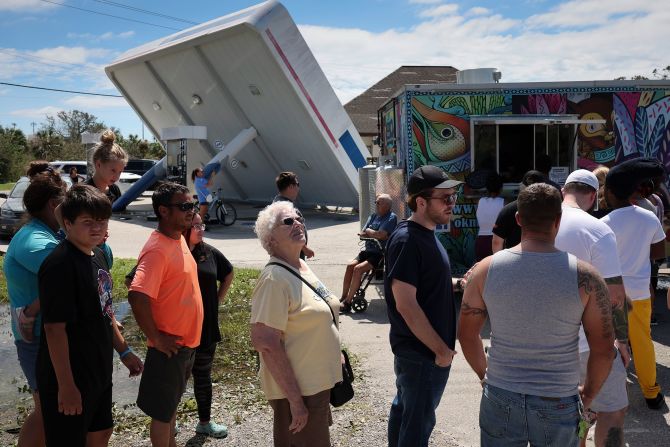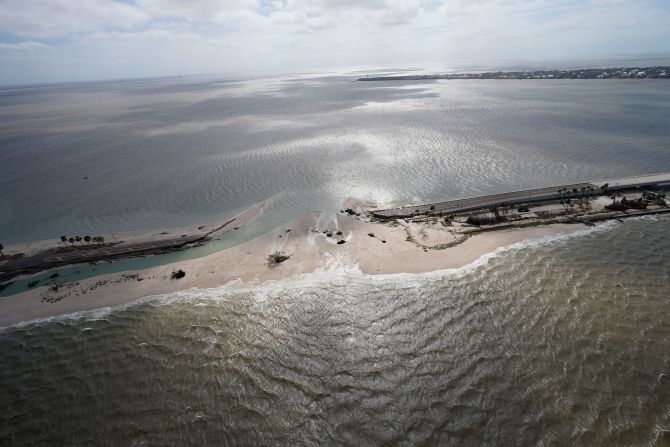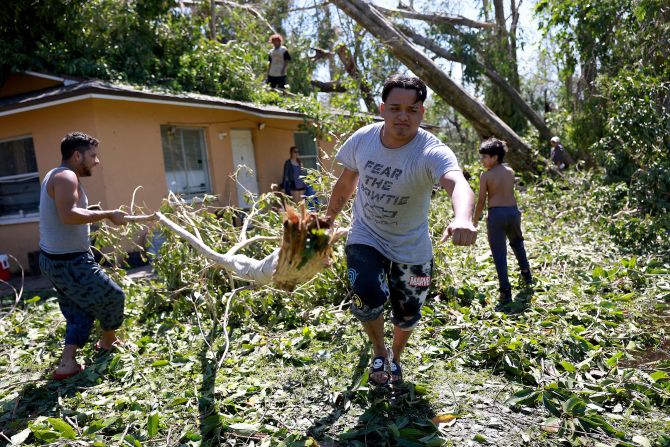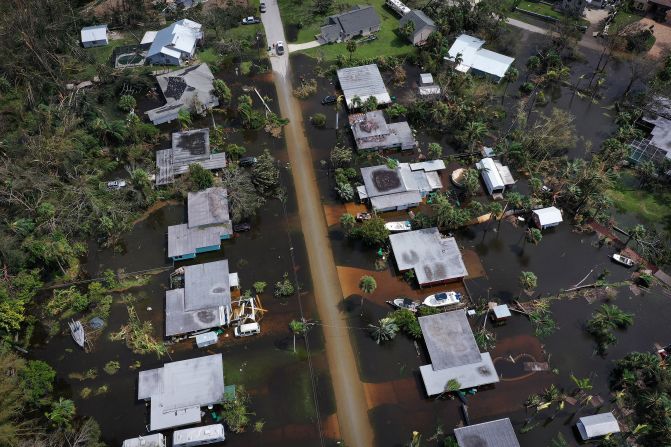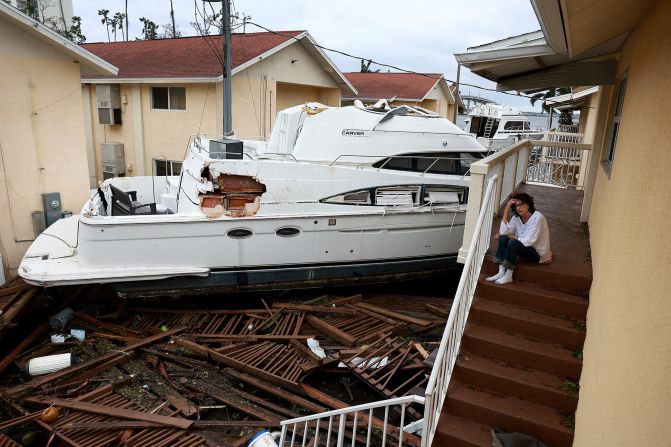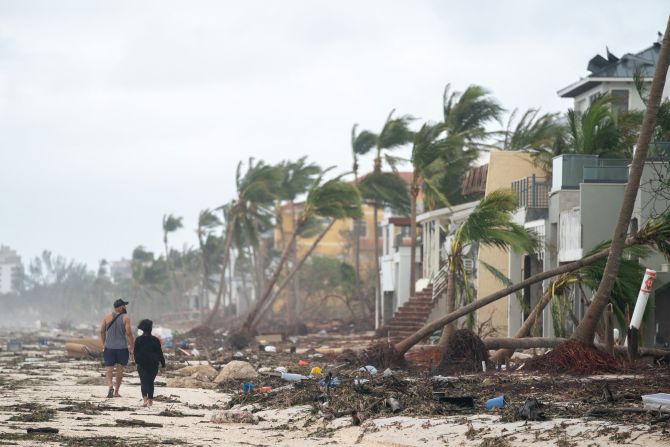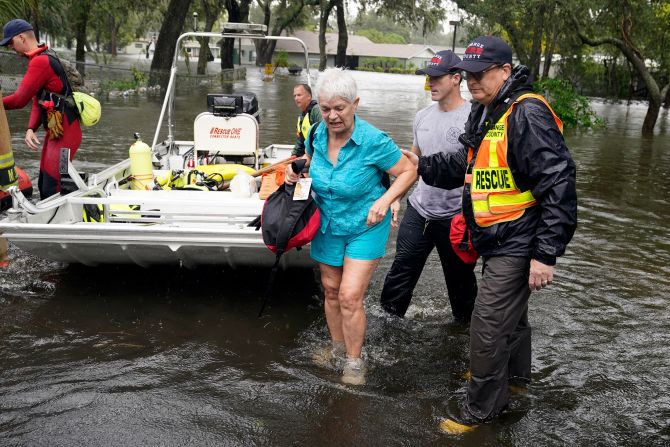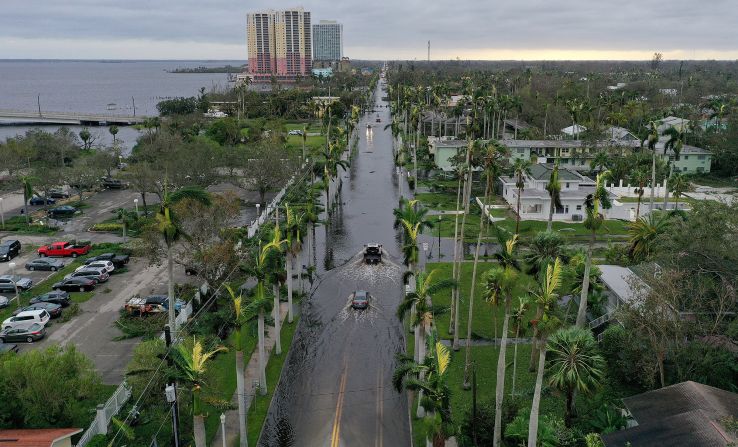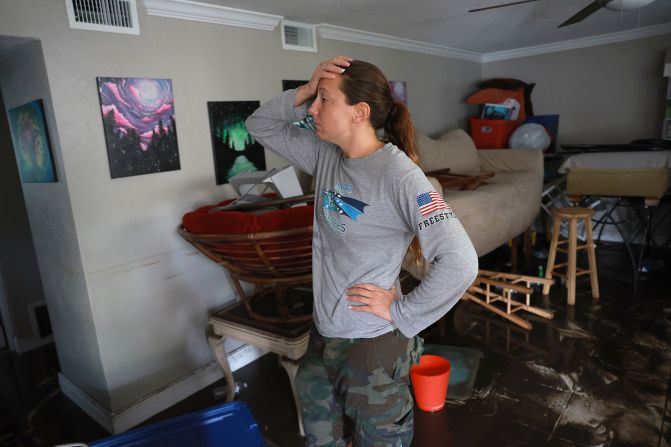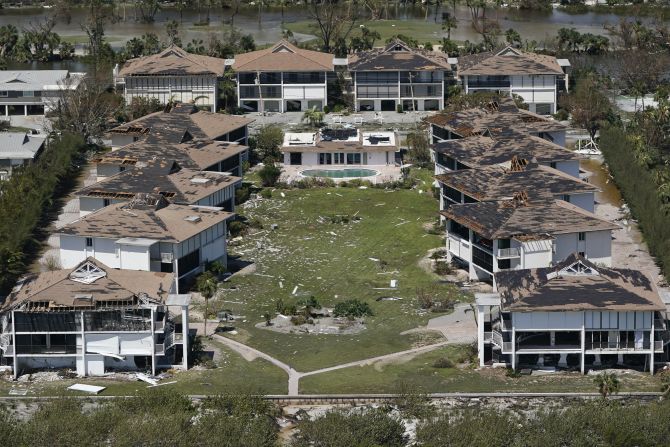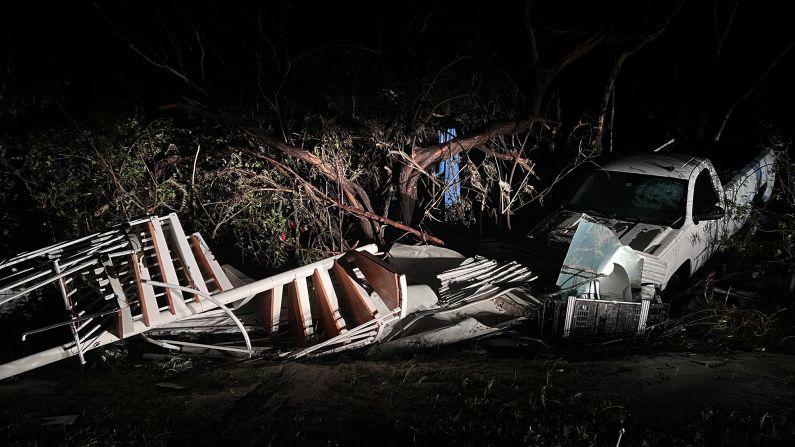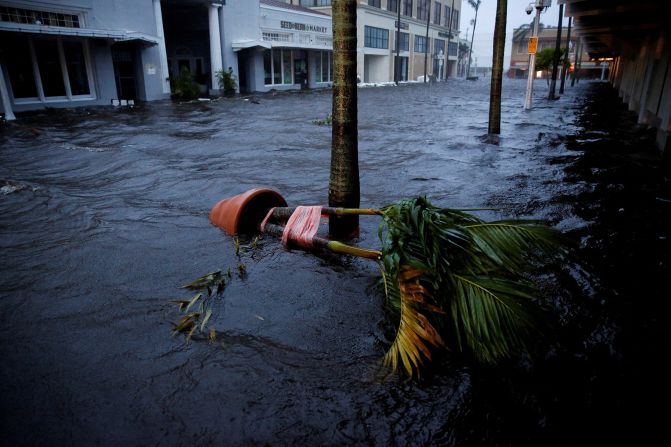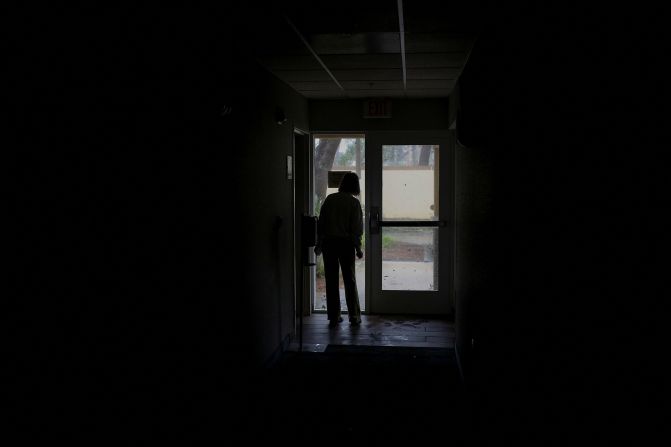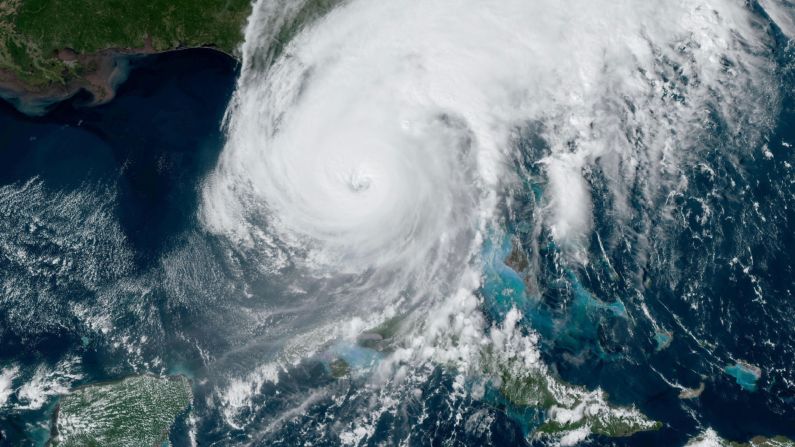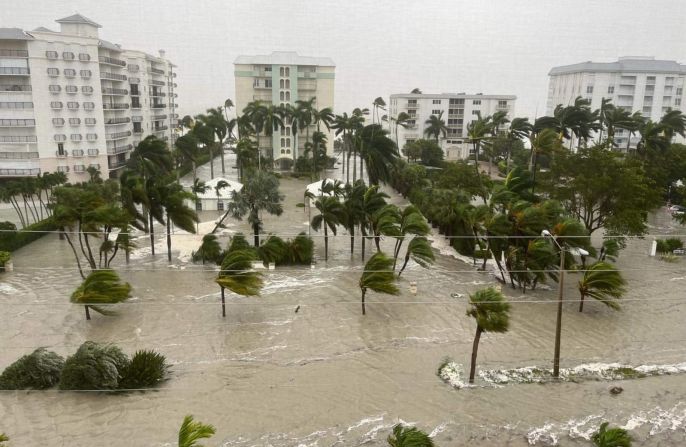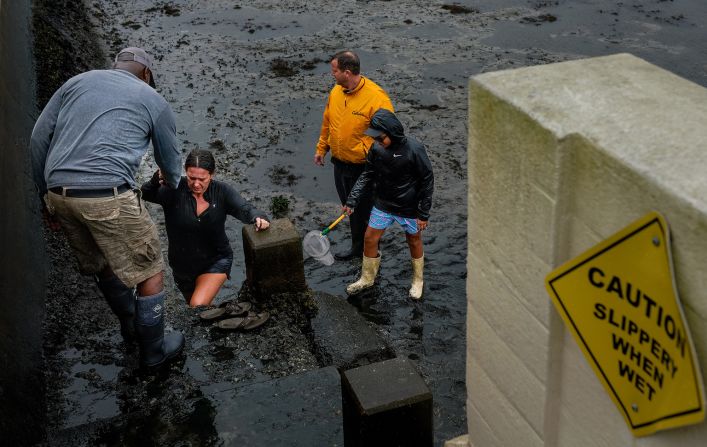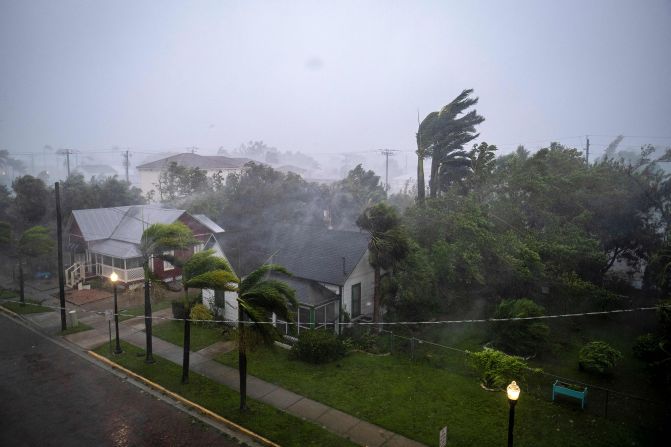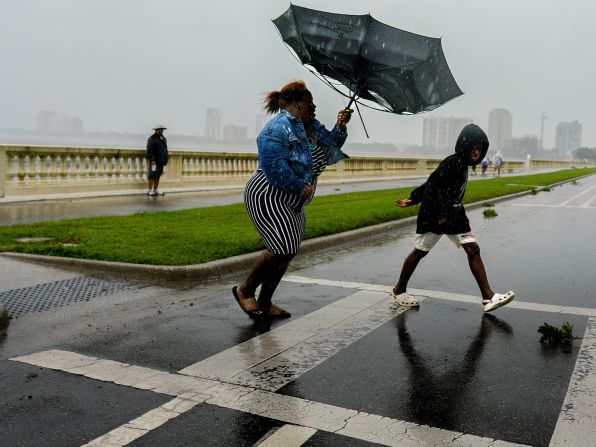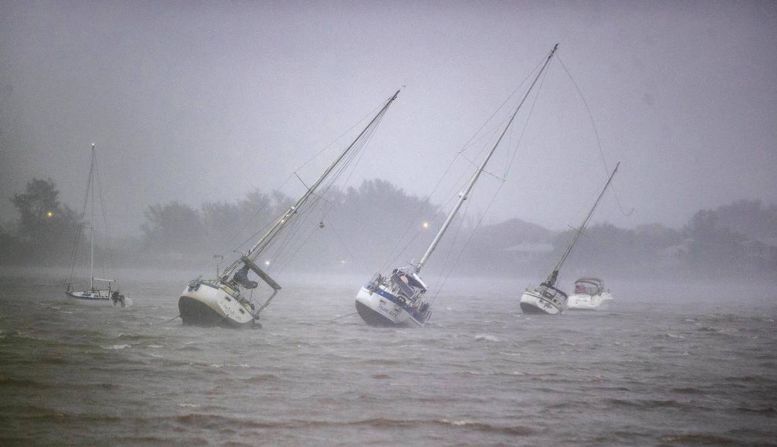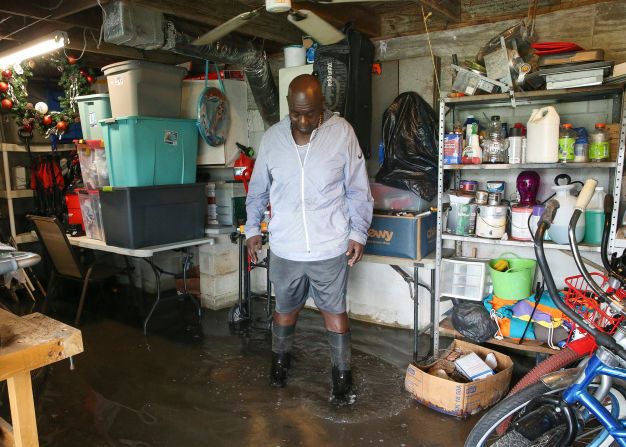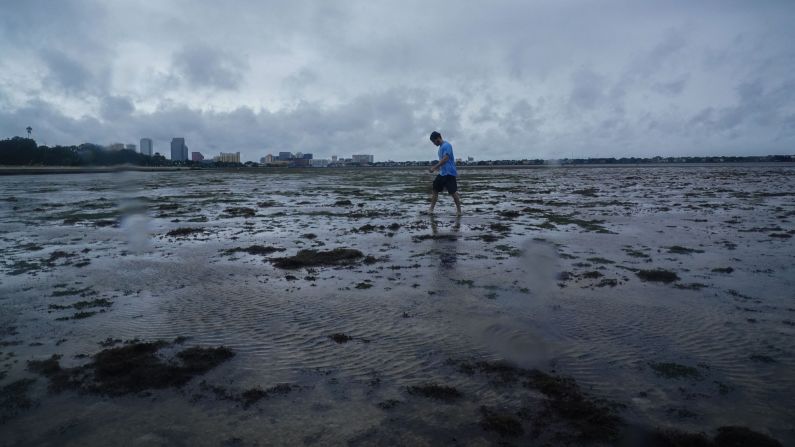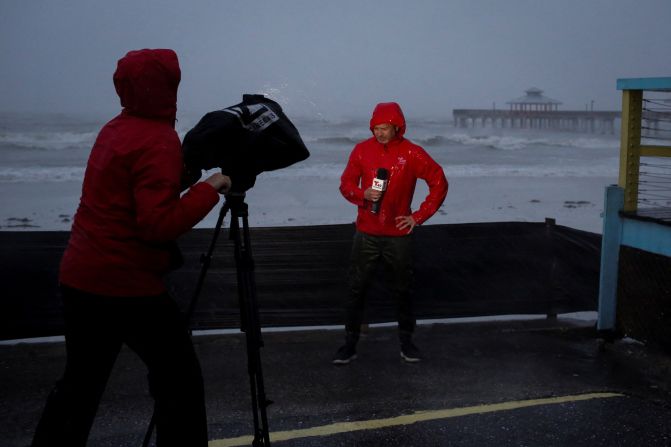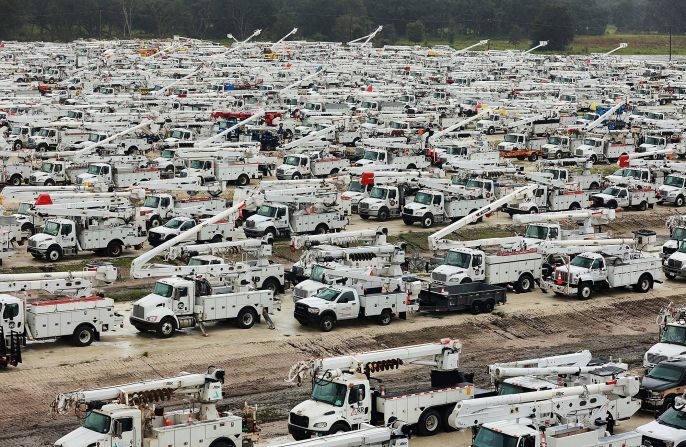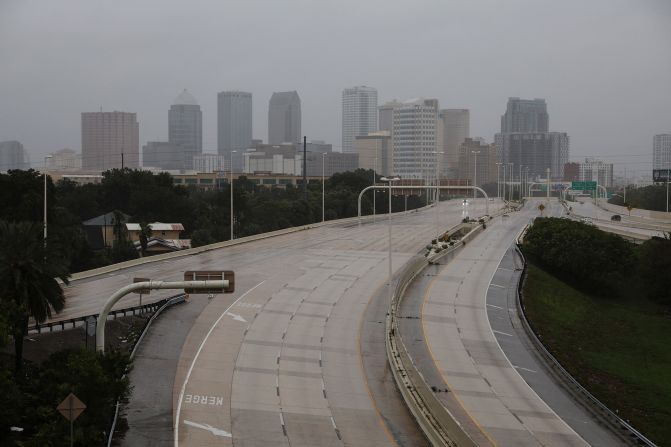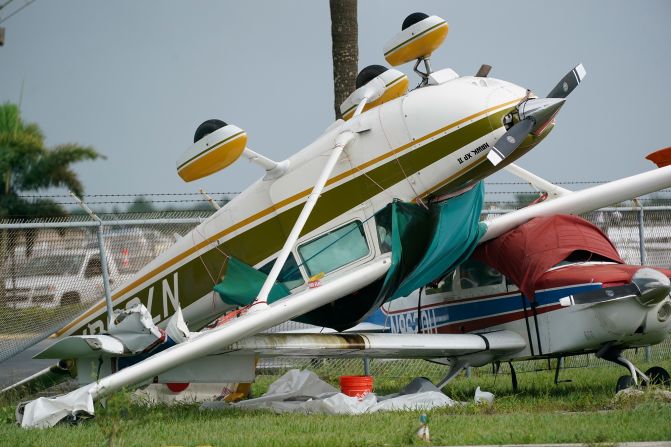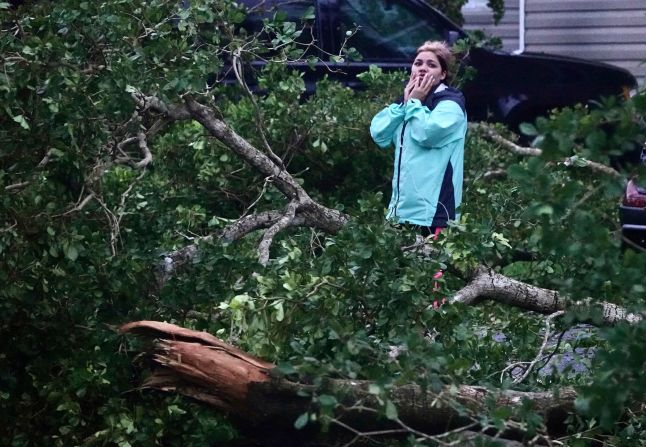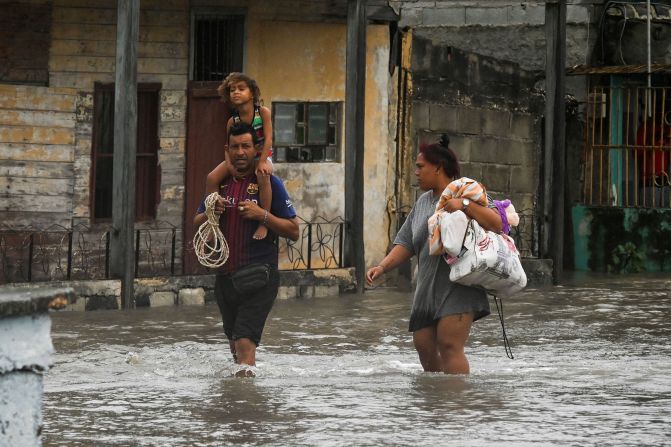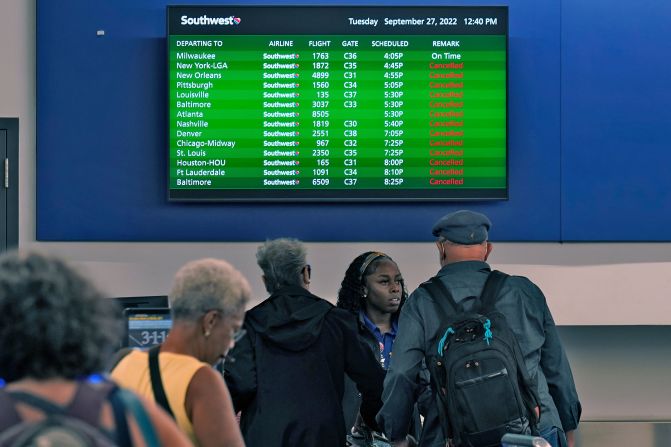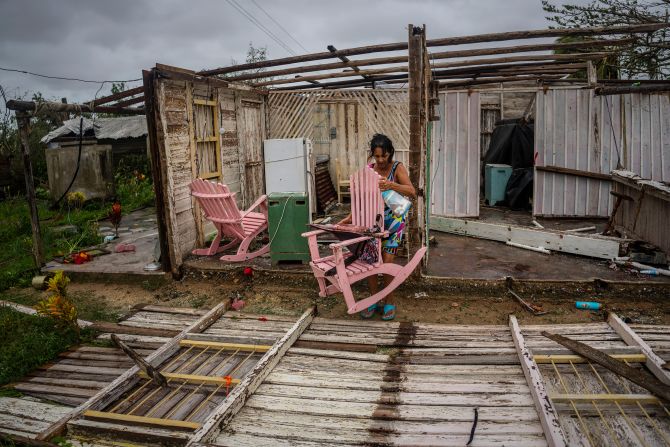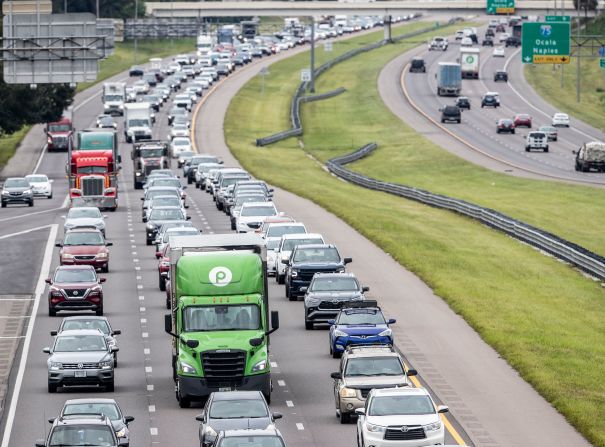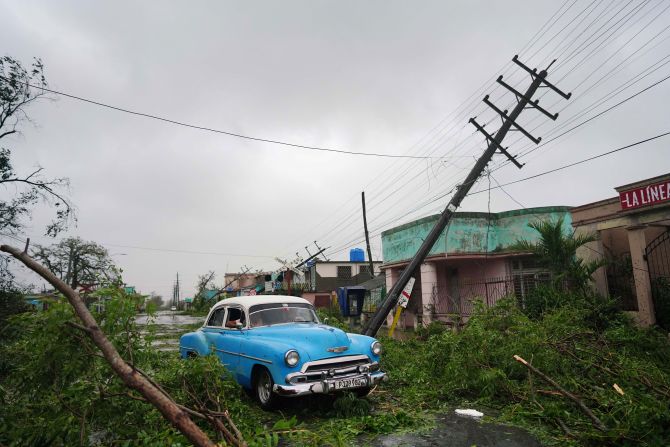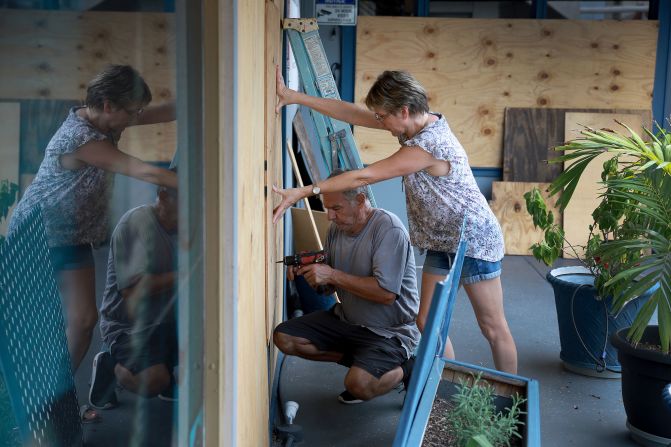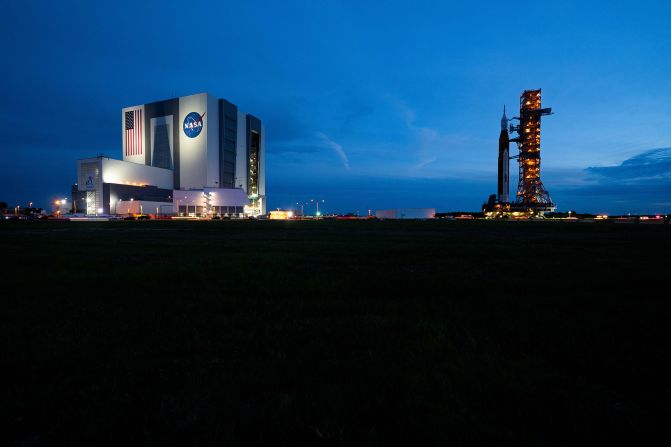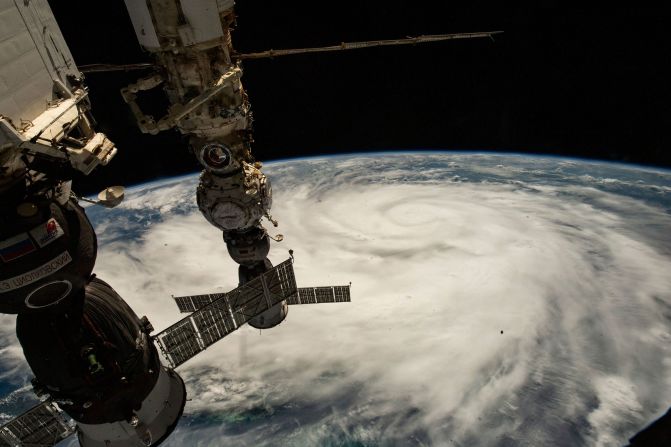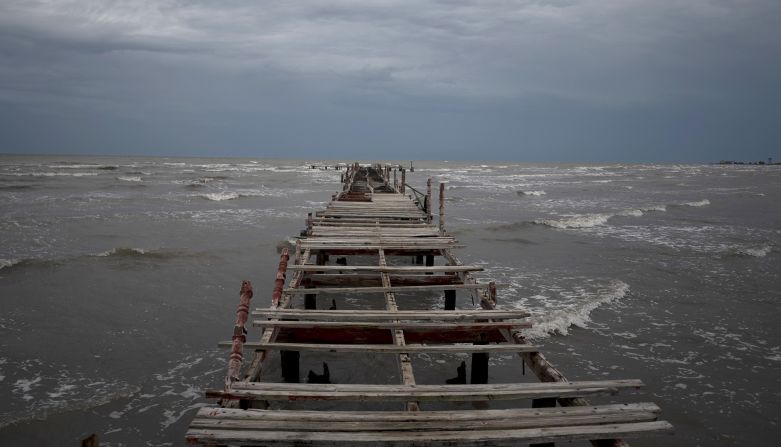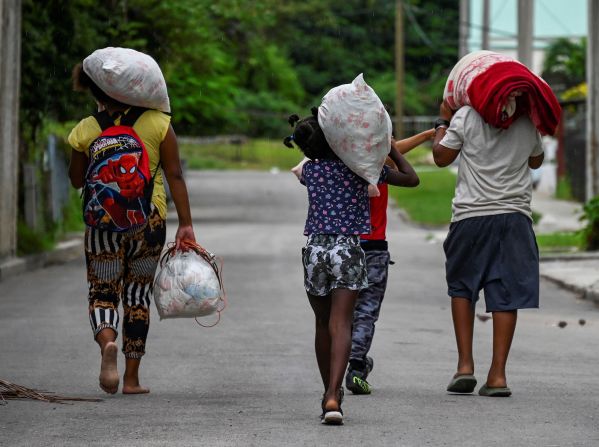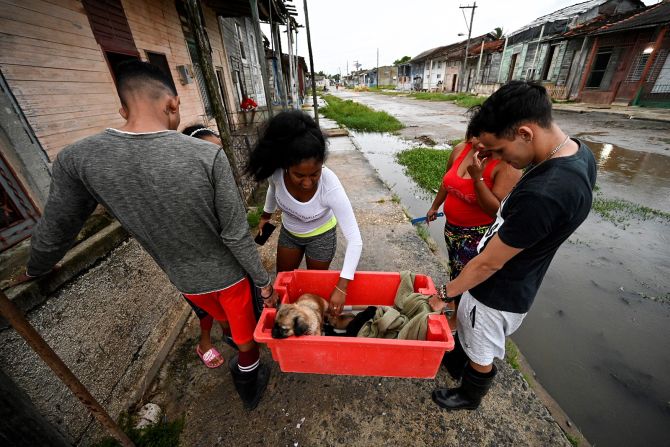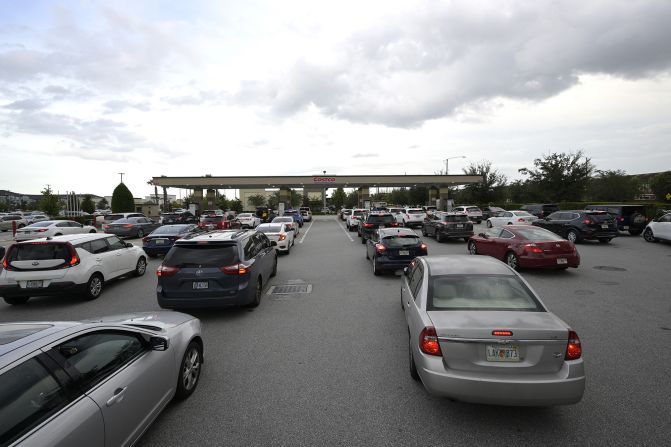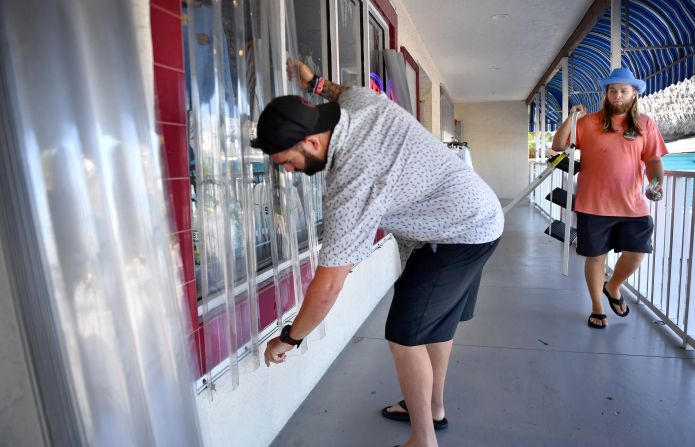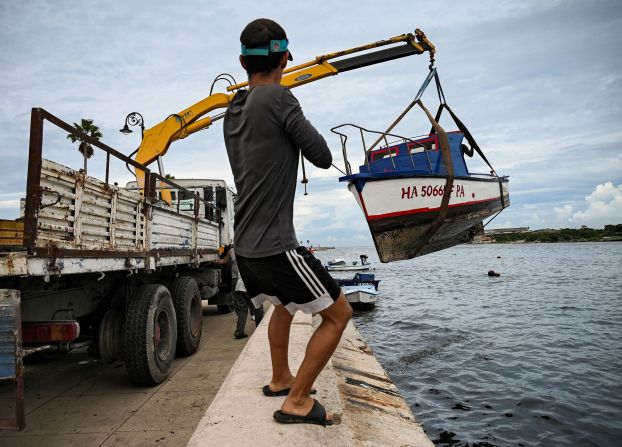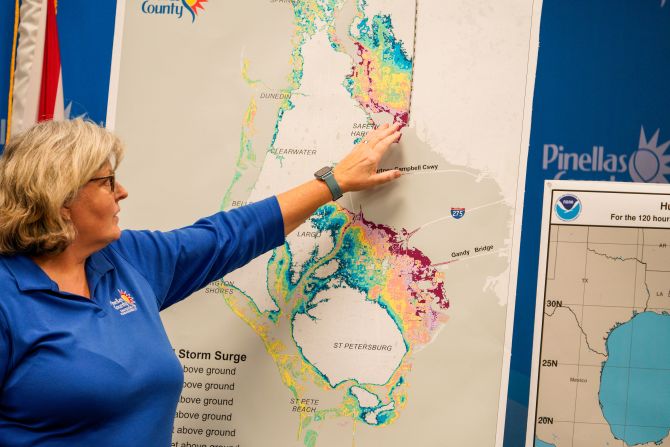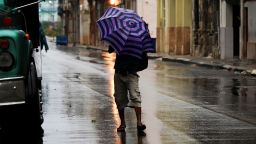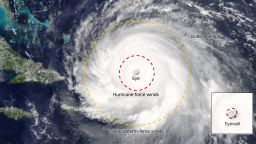Editor’s Note: Affected by the storm? Use CNN’s lite site for low bandwidth. You also can text or WhatsApp your Ian stories to CNN +1 332-261-0775. Find Thursday’s coverage here.
Hurricane Ian continued to batter the Florida peninsula with a catastrophic trifecta of high winds, heavy rain and historic storm surge Wednesday night, even as it weakened to a Category 1 storm, the National Hurricane Center said.
Amid widespread flooding, property damage, power outages and water-rescue calls, and with the slow-moving hurricane inching inland hours after making landfall along Florida’s vulnerable western coastline, officials across the state continued to issue dire warnings to residents to stay inside.
The storm surge along the west coast of Florida has peaked and is beginning to recede as the storm moves inland, according to the hurricane center.
However, “water levels are quite high in those areas still and so it will take some time for the water to recede,” Cody Fritz, storm surge specialist at the National Hurricane Center, warned.
“There’s still plenty of onshore flow along the coast keeping water levels elevated, so while the peak surge values will decrease here relative to previous value, I still expect waters to be up for awhile and the need to maintain the storm surge warnings,” Fritz said.
In Collier County, authorities have been inundated with water rescue calls. The Sheriff’s Office said it’s in “call triage mode” and getting numerous calls of people trapped by water.
“At this point the majority of our 911 calls are water rescues,” Collier County Sheriff’s Office Chief Stephanie Spell told CNN in a phone call.
In pictures: Hurricane Ian slams the Southeast
Spell could not specify how many calls have come in at this time nor comment on injuries.
“Water is everywhere,” according to a Sheriff’s Office statement late Wednesday, which added that “our East Naples deputies did 30 rescue missions today. We are still collecting numbers from other areas. We are still rescuing people.”
“Some are reporting life threatening medical emergencies in deep water. We will get to them first. Some are reporting water coming into their house but not life threatening. They will have to wait. Possibly until the water recedes,” a post on the county’s Facebook page read.
To make matters worse, the Lee County’s 911 system is down and calls are be rerouted to Collier County Sheriff, according to the post. “You can’t imagine the calls,” the post read.
A mandatory curfew was put in place for all of Collier County beginning at 10 p.m. Wednesday and ending at 6 a.m. Thursday, the county government tweeted Wednesday.
Lee and Charlotte counties have also implemented curfews. Lee County’s began at 6 p.m. and is in place until further notice, while Charlotte County’s begins at 9 p.m. and ends at 6 a.m.
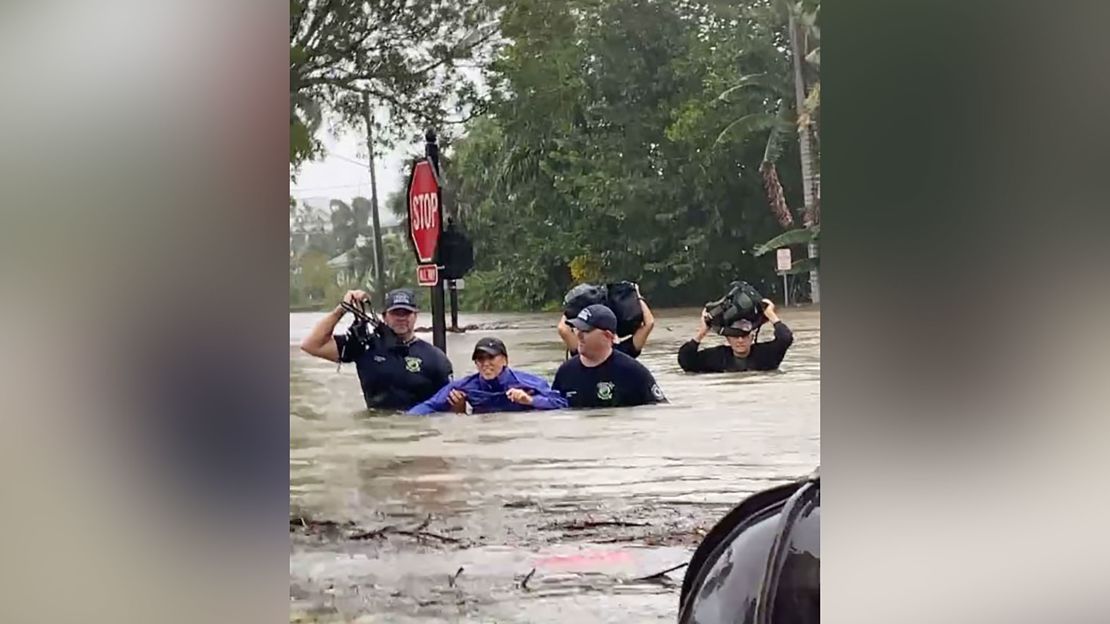
In Punta Gorda, CNN’s Randi Kaye took shelter in a parking garage as she described how the streets were devoid of people and cars. Trees were either knocked down or standing and stripped bare. Debris could also be seen flying down the street and the only vehicle visible in the city had “STORMCHASER” written on the side.
The storm made landfall as a Category 4 near Cayo Costa around 3:05 p.m., with winds near 150 mph, according to the hurricane center. At this point, Hurricane Ian is tied for the strongest storm to make landfall on the west coast of the Florida peninsula, matching the wind speed of Hurricane Charley in 2004. Florida Gov. Ron DeSantis said Wednesday Ian will rank as one of the top five hurricanes to ever hit the Florida peninsula, behind Hurricanes Andrew (1992) and Michael (2018).
Ian weakened to a Category 1 hurricane by Wednesday night as it moved across central Florida, churning sustained winds of 90 mph.
Nearly 2 million Florida utility customers were without power as of 6 p.m., according to PowerOutage.us. Officials in Cape Coral and Punta Gorda reported significant impacts, and the storm surge set records for the highest water levels ever observed in Fort Myers and Naples.
“The storm surge is very significant. We’re seeing cars and boats float down the street. We’re seeing trees nearly bent in half,” Frank Loni, an architect from California staying in Fort Myers Beach for the storm, said midday Wednesday. “There’s quite a bit of chaos on the streets.”
DeSantis said storm surge from Ian has hit up to 12 feet in some areas.”It is our meteorologist’s view that the storm surge has likely peaked and will be less in the coming hours,” he said.
Ian is expected to retain hurricane strength through the day and into tomorrow as the center of the storm moves northeast over the Florida Peninsula, passing close to Orlando and Daytona Beach, before moving back into the Atlantic Ocean Thursday afternoon. Hurricane warnings have been issued for not only southwest Florida, but also much of central Florida from coast to coast.
A number of other weather advisories have also been issued throughout Florida. A flash flood emergency impacting more than 300,000 people is in effect south central Sarasota county, southeast Manatee, northwest Desoto, Hardee, and northwest Highlands counties through 10:45 p.m..
An extreme wind warning is in effect for Sebrin, Avon Park and Arcadia until 9:30 p.m. for extremely dangerous hurricane winds as the storm passes.
‘The worst storm I have ever seen’
Water levels in Fort Myers rose more than 6 feet over the span of seven hours and were still rising as strong winds continue to push water from the Gulf of Mexico ashore, according to CNN Meteorologist Brandon Miller.
“I’ve been here since the mid-70s, this is actually – by far – the worst storm I have ever seen,” Fort Myers Mayor Kevin Anderson told CNN’s Jake Tapper.
About 96% of Fort Myers is without electricity, Anderson told CNN’s Anderson Cooper late Wednesday. The mayor does not know how many people did not heed evacuation orders, but there are thousands currently in shelters.
Anderson also emphasized that it is still unsafe to be outside and that people should stay away from floodwaters.
“There’s no telling what’s in those waters, they are not safe. You know you could step on debris. You know, there’s runoff from sewers and just – it’s just not a good situation,” he said.
Jennifer Dexter, a spokesperson for the town of Fort Myers Beach, told CNN backup water pumps are down.
“When the backup water pump system goes down, that shows you how serious it is,” Dexter said. A boil water notice went into effect due to storm surge, loss of power and damage to the backup generators for the drinking water supply.
President Biden spoke with the mayor Wednesday, the White House said in a statement. The two leaders “discussed Fort Myers’ ongoing needs including support for the elderly members of the community, families that live in mobile homes and other community members who are particularly vulnerable to the impacts of the storm,” according to a readout of the call provided by the White House.
The President also tried to reach the mayors of Cape Coral, Sarasota and the Chair of Charlotte County, Florida, but was unable to reach them and left messages instead, the White House said.
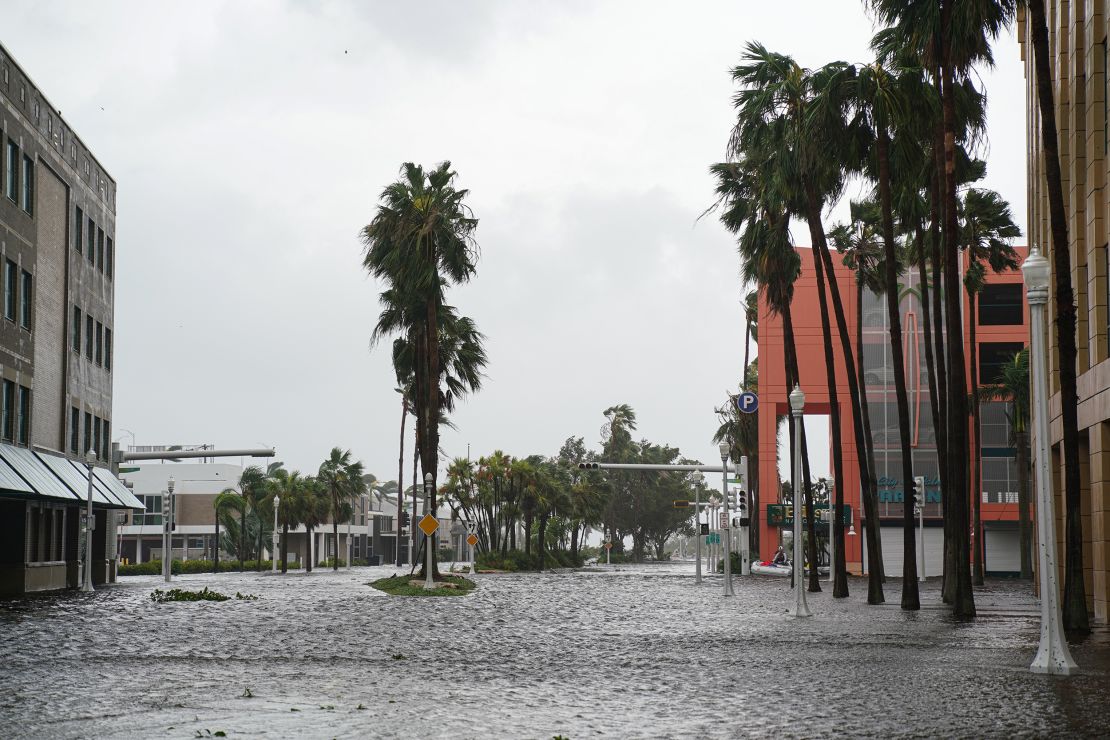
In Tampa, Mayor Jane Castor urged residents Wednesday to shelter in place, saying the worst of the storm is “yet to come.”
“We are expecting that we’re going to get the majority of the rain and the higher winds starting about 8 p.m. and they’re going to last throughout the night,” she said. “We are still expecting widespread flooding throughout our city, and anywhere from tropical storm wind speeds to the possibly of category one hurricane wind speeds.”
Castor said that officials are expecting flooding sometime in the next 24 hours.
“We’re going to see the continued rain, the rain will increase dramatically and then that water is going to come back into the Bay as Hurricane Ian continues its northeasterly trajectory.”
Further south, The Olde Naples Seaport, a community of condos that overlooks the Naples Bay, was consumed by storm surge, according to video shot by Graham Pederson. Pederson experienced knee-high water trying to escape.
In another video shot from the second floor, wind is seen whipping trees and trucks nearly submerged by the water. Pederson retreated to the second floor to wait out the storm, his brother-in-law Kyle Wendel told CNN.
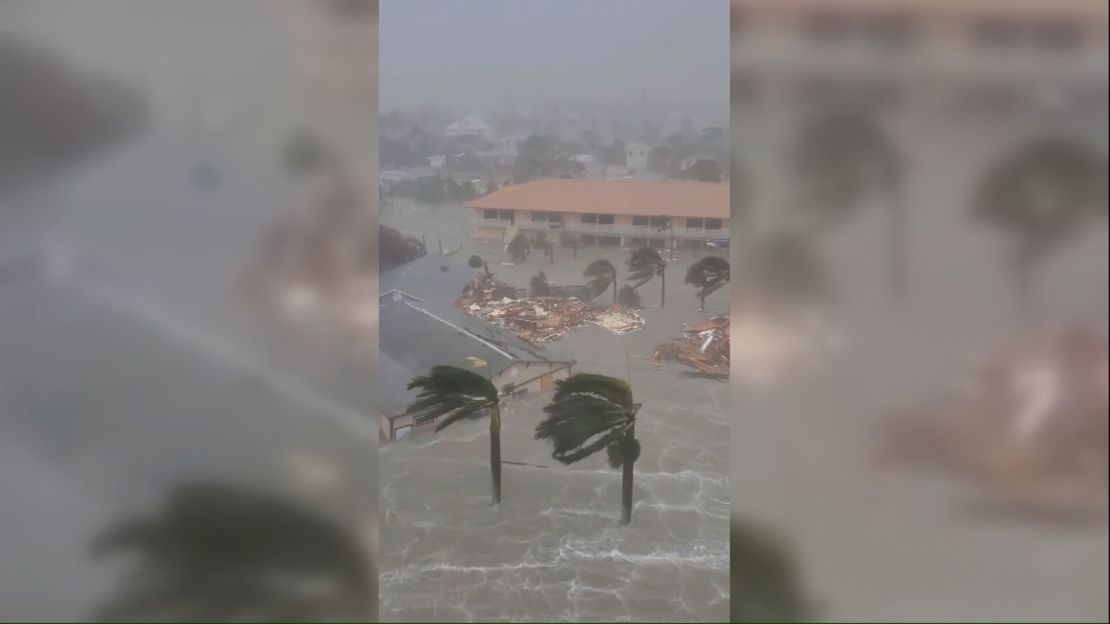
DeSantis said Wednesday calls for help are coming into several counties due to the storm. The governor said emergency responders have received calls from people in evacuation zones that did not evacuate. Those calls are being logged, he said.
“Local first responders will deploy as soon as it’s safe to do so,” DeSantis said. “By and large until the storm passes, they are not going to go into a situation for rescue and put their own folks at risk.”
DeSantis requested Biden approve a major disaster declaration for all 67 counties in the state due to Hurricane Ian, his office said in a news release. DeSantis is also requesting that the President grant FEMA the authority to provide 100% federal cost share for debris removal and emergency protective measures for the first 60 days from Ian’s landfall.
Ian already producing record water surge levels
Much of west-central Florida and places inland face “historic” storm surge, rain and crushing winds. “This is a wind storm and a surge storm and a flood storm, all in one,” CNN meteorologist Chad Myers said.
Images and video have showed extensive flooding in coastal neighborhoods in Naples and Fort Myers Beach.
Storm surge began rising late Wednesday morning – more than 4.5 feet above normal highest tides was recorded before noon in Naples, already higher than the previous record there of 4.02 feet from Hurricane Irma in 2017.
Mandatory evacuations were ordered for flood-prone areas on the coast, and the National Weather Service warned those who stayed behind to move to upper floors in case of rising water levels.
Ian’s dangers still include:
• Storm surge: Some 12 to 18 feet of seawater pushed onto land was predicted Wednesday for the coastal Fort Myers area, from Englewood to Bonita Beach, forecasters said. Only slightly less is forecast for a stretch from Bonita Beach down to near the Everglades (8 to 12 feet), and from near Bradenton to Englewood (6 to 10 feet), forecasters said.
Lower – but still life-threatening – surge is possible elsewhere, including north of Tampa and along Florida’s northeast coast near Jacksonville.
• Winds: Southwest Florida is facing “catastrophic wind damage” from ongoing hurricane-force winds. Winds near the core of Hurricane Ian could exceed 140 mph, with higher gusts, the hurricane center said. Multiple locations, including Sanibel Island, recorded wind gusts above 100 mph.
• Flooding rain: 12 to 30 inches of rain could fall in central and northeastern Florida – including Tampa, Orlando and Jacksonville. That makes for a top-of-scale risk for flooding rainfall across this area. This amount of rain would usually be two to three months’ worth, but is now falling in less than two days, according to CNN meteorologist Gene Norman.
“As this storm passes your community, understand this is still a hazardous situation” because of downed powerlines, misuse of generators and standing water, Gov. DeSantis said during a Wednesday evening news conference.
Where the hurricane is headed
Ian’s center is expected to move over central Florida through Thursday morning. Heavy rain and flooding also is possible in southern Florida, Georgia and coastal South Carolina. The governors of Virginia, North and South Carolina have already declared states of emergency in their respective states.
Storm warnings have expanded northward to North Carolina, according to the National Hurricane Center’s 5 p.m. update. A tropical storm warning has been extended to Surf City and a tropical storm watch has been issued from north of Surf City to Cape Lookout, North Carolina.
A storm surge watch has been issued north of South Santee River, South Carolina, to Little River Inlet.
Because Ian slowly approached land, the worst conditions could remain over some areas for eight or more hours.
“Widespread, life-threatening catastrophic flash, urban, and river flooding is expected” across central and southern Florida, the hurricane center said.
By late Thursday, Ian is due to emerge over the Atlantic Ocean, where it could strengthen again and affect another part of the US.
Prior to nearing Florida, Hurricane Ian pummeled Cuba on Tuesday, leaving at least two dead and an islandwide blackout. The US Coast Guard said it has rescued at least three people off the Florida coast, about 2 miles south of Boca Chica.
“They were brought to the local hospital for symptoms of exhaustion and dehydration. Air crews are still searching,” the Coast Guard said in a tweet.
According to US Border Patrol Chief for the Miami Sector, the agency has been searching for more than 20 migrants after the arrival of Cubans who swam to shore after their boat sank due to Ian.
After the devastation in Cuba, more than 2.5 million people in Florida were advised to flee, including 1.75 million under mandatory evacuation orders – no small ask in a state with a large elderly population.
Officials prepare for post-storm rescue
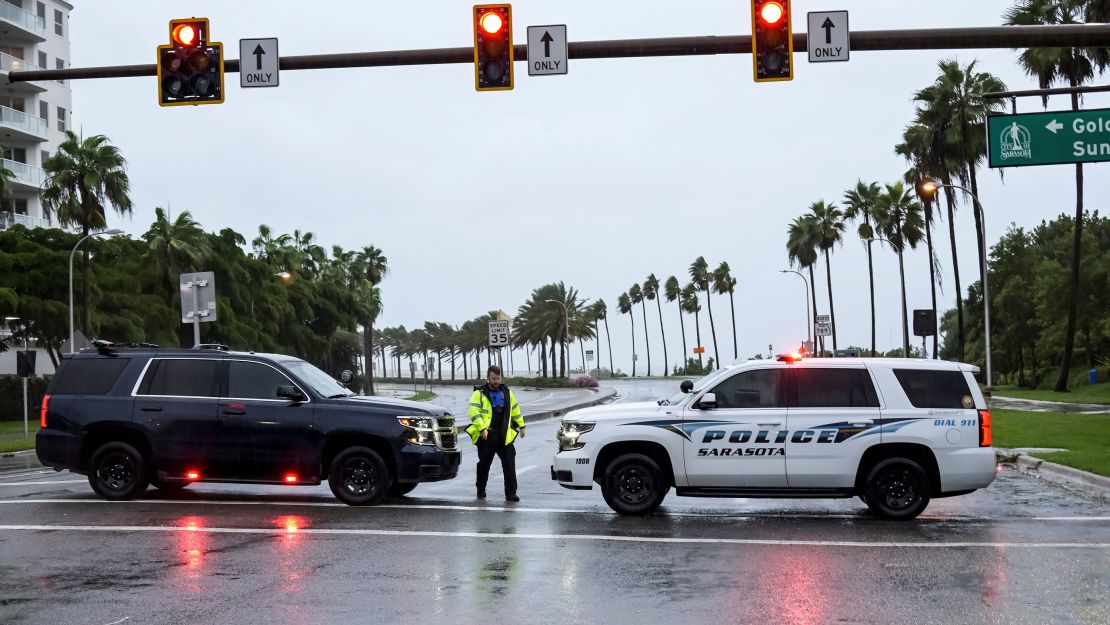
Law enforcement officials around the state warned that people who stayed behind in evacuation areas cannot expect rescuers to respond to calls for help during the storm when winds are high.
“If you call for help, once we pull (officers) off the road … we’re not coming. … We’re not putting people in peril when (others) didn’t heed the mandatory evacuation order,” Pinellas County Sheriff Bob Gualtieri said Wednesday.
Not everyone moved. Chelsye Napier, of Fort Myers, stayed home with her fiance and cats despite being in an evacuation zone, she told CNN Wednesday. They waited “because we don’t know anyone down here,” and ultimately decided to stay put, she said.
Ian's winds could be catastrophic
Category 4: 130-156 mph
“If anything happens, we have everything that we need here. We’ve got food, we got water. We have everything that we need here,” she said. “So it’s all OK for right now. We’ll see, though, later on.”
As millions were told evacuate, 176 shelters opened statewide and hotels and Airbnbs opened to people leaving evacuation zones, DeSantis said.
Local governments and state agencies also prepared those living in nursing homes and other senior care facilities to evacuate. Florida has around 6 million residents over the age of 60, according to the state’s Department of Elder Affairs – nearly 30% of its total population.
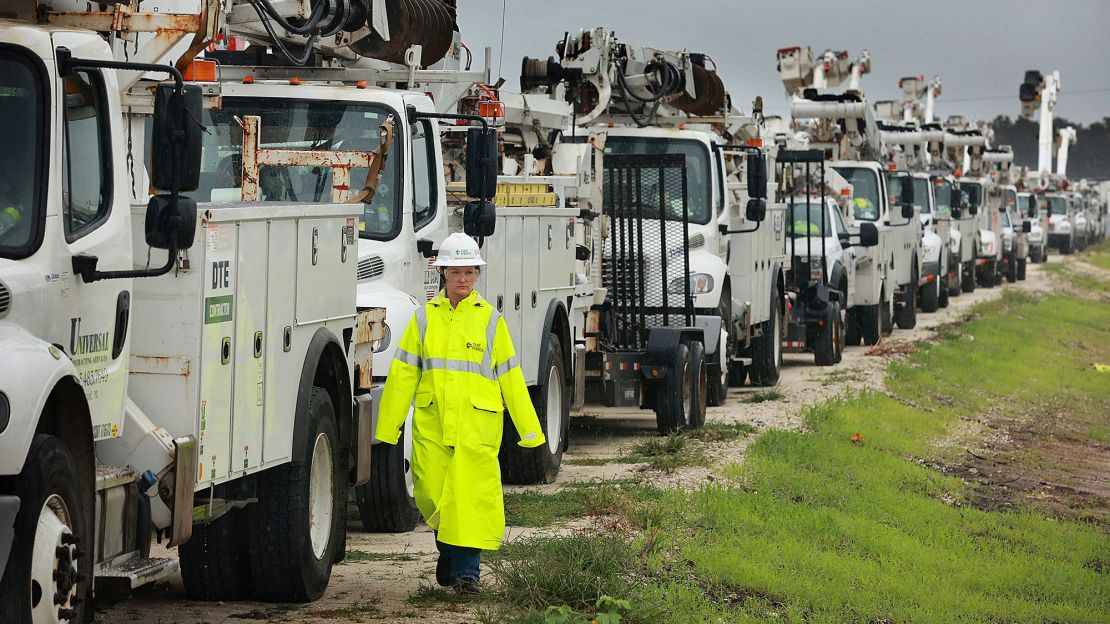
Authorities also readied services to fan out and respond to calls for rescue and then, in the aftermath of the hurricane, for recovery and repair efforts.
Nearly 400 ambulances, buses and support vehicles were responding to areas where the hurricane was expected to make landfall, according to the governor’s office.
DeSantis activated 5,000 Florida National Guard members for Ian’s response operations, and 2,000 more guardsmen from Tennessee, Georgia and North Carolina were being activated to assist.
Florida urban search and rescue teams also were prepping.
“We have five state teams that are activated with additional five FEMA teams that are in play,” Florida Chief Financial Officer Jimmy Patronis said at a news conference Tuesday night. “We have over 600 resources to bear in addition to these out-of-town teams.”
Help is coming from out of state, too. At least 26 states have answered the call for assistance by Florida, DeSantis said Wednesday evening, including Alabama and Louisiana.
Louisiana Gov. John Bel Edwards tweeted Wedensday his state has already sent “significant resources” to Florida.
“We are also prepared to send additional help once damage assessment begins,” Edwards’ tweet read.
Alabama Gov. Kay Ivey tweeted her state sent Blackhawk helicopters to help. Tennessee and Louisiana also sent resources to aid in search and rescue.
“If they need it and we’ve got it, then we’re going to send it,” Ivey tweeted.
CNN’s Sharif Paget, Virginia Langmaid, Nikki Carvajal, Amy Simonson, Judson Jones, Brandon Miller, Allison Chinchar, Michelle Krupa, Amanda Musa, Jamiel Lynch, Melissa Alonso, Amanda Watts and Rachel Ramirez contributed to this report.




